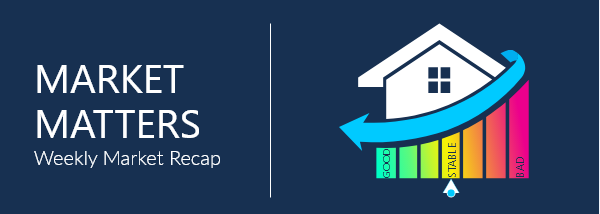Market Matters

We saw a continuation of the volatility from the latest Covid variant Omicron, as well as an even more bearish Fed this week. Omicron is still a big unknown for the time being, but we should have a better feeling for how easily transmissible it is and how severe the symptoms are compared to the Delta variant in the next few weeks. That news sent the markets significantly lower on the 10-year, while Fed Powell’s comments on the Fed increasing their rate of tapering their asset purchases spooked both bond and equity markets. Keep an eye on the new variant and the Fed as one of those two topics is leading the market for the time being.
 Initial Jobless Claims
Initial Jobless Claims
Initial Jobless Claims rose +28k to 222k in the week ended November 27th vs. the prior week’s revised level of 194k (orig. 199k). The 4-week moving average fell to 238.8k from 251k, which is now the lowest since March 2020. Continuing claims, which lag a week, fell by -107k to 1.956mln from a prior 2.063mln (revised from 2.049mln). This is the first time that continuing claims have fallen below the 2mln mark since the early days of the pandemic. The last time continuing claims were lower than the current 1.96mln was back on March 14, 2020.
 Monthly Jobs Report
Monthly Jobs Report
We saw a big top line miss at 210k jobs vs 550k expected. Unemployment rate came in at 4.2% vs. expected 4.5%. Average weekly earnings were a bit light as well at +0.3% vs +0.4%. The household survey seemed strong, but the employer survey was weak. The market is still pricing in a faster taper and how aggressive the Fed will be with rate hikes is the question.
 ADP Employment Report
ADP Employment Report
The ADP Employment Report for November showed private payrolls up +534k vs. expectations of +525k. Revisions were seen in prior months as well, with September up another +3k to +526k, and October down -1k to +570k. Within the data, goods-producing industries showed gains with +110k in net payrolls. Service-providing payrolls slipped to +424k from a prior +458k, which is now the third lowest reading over the past nine months. Overall, goods-producing sectors have made up 91.6% of their losses, while service-providing sectors have recovered 75%. By company size, hiring was a little more evenly distributed, but still tilted toward large businesses (500+ employees), which added +277k. Medium-sized businesses (50-499 employees) added +142k, and small businesses added +115k. Small businesses have recovered 91% of the early-COVID losses, mid-sized businesses have made up 83.7%, and large businesses only 65.4%.
 ISM Manufacturing PMI
ISM Manufacturing PMI
The ISM Manufacturing PMI rose +.3 to 61.1, back to its levels from September. Within the internals, the new orders index rebounded +1.7 to 61.5, and production rose +2.2 to 61.5, its healthiest since April. Meanwhile, the supplier delivery time index fell -3.4 to 72.2, a three-month low, and the prices number fell by -3.3 to 82.4, its third lowest of the past ten months. Backlogs decreased by -1.7 to 61.9, their lowest since January. In addition, the employment index rose +1.3 to 53.3, its strongest since April. Respondent comments continued to be heavily focused on supply shortages and recruiting difficulties.

